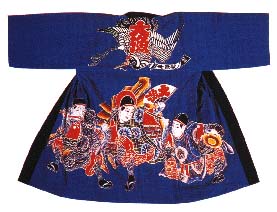Dye (p. 73 )
1. Produced in Choshi City, Chiba Prefecture. Takamatsu City, Kagawa Prefecture.
2. Characteristics: A simple method of dyeing with glue resistant. The glue is put in a cylinder made of paper and squeezed out from the tip. There are various designs including those eye-catching lines and outlines which can not be produced by stencils.
3.Uses: Bedding,"Noren", "Yutan"(oil cloth), "Tairyo bata"(good catch flag), "Maiwai"(good catch party clothes), wrapping cloths used at festivals, carp streamers, banners, advertisement curtains.
4. History: The dyeing method using glue resistant is applied in stencil dyeing and hand dyeing("Tsutsugaki Zome" and"Yuzen"). It was originated in China and brought to Japan via "Ryukyu"(Okinawa) or via Korea. "Kaga Zome" and "Yuzen Zome," in which the glue resistant method is used, appeared in Japan in the Genroku Era, while "Tsutsugaki Zome" was in use in Okinawa in the late 1560ユs. It is said that "Tsutsugaki Zome" was transmitted by traders to the districts on the coast line for fabrics of specific mode for fishermen.
Dyeing Method
Sketches are first drawn with "Aobana," juice of flowers of "Murasaki Tsuyukusa"(dayflower, Commeline communis) and glue, made of glutinous rice and rice bran, is used. Colored glue is also used. A good catch flag in Choshi is dyed dynamically with several kinds of dyes by several dyers. Both designs and backgrounds are dyed with brushes. No plant dyes are used today only chemical dyes.



